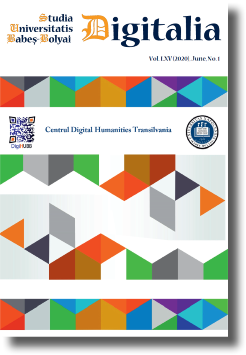DaT18 Database: A Prosopographical Approach to the Study of the Social Structures of Religious Dissent in Mid-Eighteenth-Century Transylvania
DOI:
https://doi.org/10.24193/subbdigitalia.2020.1.04Keywords:
prosopography, relational database, clerical careers, data structuring, Greek Orthodox Church.Abstract
Drawing on the many records created by the Habsburg state during the confessional troubles in Transylvania from the 1740s to the 1760s, the DaT18 project merges digital instruments and prosopography to arrive at sketching the social pattern of the Orthodox leadership. This article briefly discusses the technical choices involved in building the relational database that my approach centres on, before talking in more detail about the challenges faced when transposing the information in the primary sources into digital format. First, the question of making use of structured vs. unstructured data, as most of the documents I work with already present some form of tabular layout, while the more narrative ones require different strategies to mitigate losses when converting them. Secondly, the difficult process of record linkage, with many of the persons only mentioned by their first name and no surname to help label each individual entered in more than one source. Lastly, the daunting task of estimating economic resources, since there was no reliable standard in an age that saw four different fiscal systems in use and many regional flavours within the same scheme.References
Bernath, Mathias. Habsburgii și începuturile formării națiunii române. Translated by Marionela Wolf, Editura Dacia, 1994.
Bozac, Ileana, and Teodor Pavel, editors. Călătoria împăratului Iosif al II-lea în Transilvania la 1773 / Die Reise Kaiser Josephs II. durch Siebenbürgen im Jahre 1773. Vol. 1, Institutul Cultural Român – Centrul de Studii Transilvane, 2006.
Burns, Arthur, et al. “Reconstructing Clerical Careers: The Experience of the Clergy of the Church of England Database.” The Journal of Ecclesiastical History, vol. 55, no. 4, 2004, pp. 726–737.
Cohen, Gidon, et al. “Towards A Mixed Method Social History: Combining quantitative and qualitative methods in the study of collective biography.” Prosopography Approaches and Applications: A Handbook, edited by K. S. B. Keats-Rohan, Occasional Publications of the Unit for Prosopographical Research, 2007, pp. 211–29.
“DaT18 Database.” Dissent and toleration in Habsburg Transylvania: A socio-political history of the Orthodox protests (1740s–1760s), Version 3.1, 2018–2020, https://www.dat18.ro/en/database. Accessed 12 May 2020.
Davis, Natalie Zemon. Fiction in the Archives: Pardon Tales and Their Tellers in Sixteenth-Century France. Stanford University Press, 1987.
Farge, Arlette. Le goût de l’archive. Éditions du Seuil, 1989.
Gyémánt, Ladislau et al., editors. Conscripția fiscală a Transilvaniei din anul 1750. Univers Enciclopedic, 2009–2016. 2 vols in 5 parts.
Hitchins, Keith. The Idea of Nation: The Romanians of Transylvania, 1691–1849. Editura Științifică și Enciclopedică, 1985.
Hitchins, Keith, and Ioan N. Beju, editors. “Documente privitoare la trecutul Bisericii Ortodoxe Române din Transilvania după 1761.” Mitropolia Ardealului, vol. 19, nos. 1–3, 1974, pp. 13–46.
Ionaș, Vasile. “Reformele fiscale din Transilvania în secolul al XVIII-lea.” Annales Universitatis Apulensis, series Historica, vol. 4–5, 2000–2001, pp. 79–90.
Keats-Rohan, Katharine. “Prosopography and computing: a marriage made in heaven?” History and Computing, vol. 12, no. 1, 2000, pp. 1–11.
Keul, István. Early Modern Religious Communities in East-Central Europe: Ethnic Diversity, Denominational Plurality, and Corporative Politics in the Principality of Transylvania (1526–1691). Brill, 2009.
Mandemakers, Kees, and Lisa Dillon. “Best Practices with Large Databases on Historical Populations.” Historical Methods: A Journal of Quantitative and Interdisciplinary History, vol. 37, no. 1, 2004, pp. 34–38.
Nedici, Radu. “Cum să pornești o revoltă în veacul al XVIII-lea: Activism, adunări publice și propagandă în comunitățile ortodoxe din Transilvania (1740–1760).” Revista Istorică, vol. 28, nos. 5–6, 2017, pp. 479–98.
———. “Religious violence, political dialogue, and the public: the Orthodox riots in eighteenth-century Transylvania.” Economy and society in Central and Eastern Europe: Territory, population, consumption, edited by Daniel Dumitran and Valer Moga, LIT Verlag, 2013, pp. 87–100.
———. “Rethinking religious dissent in mid-eighteenth-century Transylvania: Political practices and the plebeian public sphere.” Analele Universității București: Istorie, vol. 63, no. 1, 2014, pp. 101–24.
———. “Spre o istorie socială a disidenței religioase: Un inventar al surselor referitoare la protestele ortodocșilor din Transilvania de la mijlocul secolului al XVIII-lea.” Sursele unei istorii (pre)moderne românești în Moldova și Valahia, 21 September 2018, Institutul de Istorie ‘Nicolae Iorga’, Bucharest. Conference Presentation.
Roth, Paul W. “Das Diploma Leopoldinum: Vorgeschichte, Bestimmungen.” Siebenbürgen in der Habsburgermonarchie. Vom Leopoldinum bis zum Ausgleich (1690–1867), edited by Zsolt K. Lengyel and Ulrich A. Wien, Böhlau Verlag, 1999, pp. 1–11.
Townsend, Sean, et al. “Digitising History: A Guide to Creating Digital Resources from Historical Documents.” AHDS Guides to Good Practice. University of Essex, 1999, http://hds.essex.ac.uk/g2gp/digitising_history/index.asp. Accessed 12 May 2020.
Trócsányi, Zsolt. “A New Regime and an Altered Ethnic Pattern (1711–1770).” History of Transylvania, vol. 2, edited by László Makkai and Zoltán Szász, Social Science Monographs, 2002, pp. 515–618.
Downloads
Published
How to Cite
Issue
Section
License
Copyright (c) 2020 Studia Universitatis Babeș-Bolyai Digitalia

This work is licensed under a Creative Commons Attribution-NonCommercial-NoDerivatives 4.0 International License.


